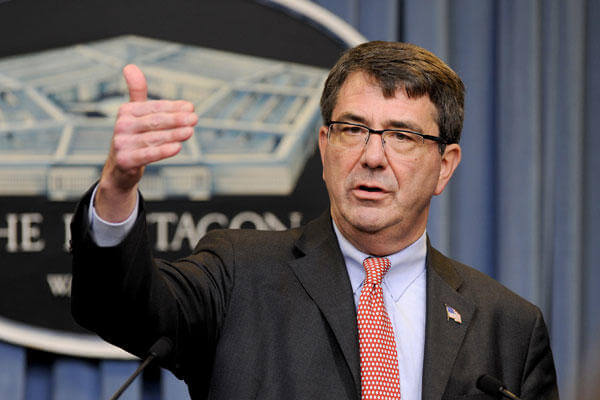The U.S. Defense Department plans to announce potentially sweeping changes to its officer promotion system "in coming months," the top official said.
Defense Secretary Ashton Carter on Thursday referenced the reforms during a Senate Appropriations Defense Subcommittee hearing on the Pentagon's proposed budget for fiscal 2017, which begins Oct. 1.
"We're taking a serious look at some commonsense reforms in our officer promotion system and I greatly appreciate congressional leaders from both parties who have indicated their support for such reforms in principle," he said in his prepared remarks.
The changes are part of an overhaul of the personnel system known as the "Force of the Future" initiative, which is being led by Deputy Defense Secretary Bob Work and Vice Chairman of the Joint Chiefs of Staff Air Force Gen. Paul Selva, who are working with the service chiefs.
Carter didn't specify whether he supports a draft version of proposals from last August calling for ending the "up or out" promotion and retention policies dating to World War II in which officers must leave if they don't reach a certain rank within a certain period of time.
"Now, as then, major personnel decisions -- including promotion, resident professional military education, involuntary separation, and career field designation -- occur in batches determined by the year in which an officer enters service, for both active and Reserve components," the document states, according to a copy posted on the website of the Project on Government Oversight, a watchdog group in Washington, D.C.
"Failure to complete all of the tasks and assignments deemed desireable by the promotion board in the alloted time often resulted in failure of selection," it states.
The document continues, "Unnecessary loss of talent due to the arbitrary nature of career timing represents a tremendous opportunity cost to the Department and the Nation, ample opportunities exist for improvement. For example, in order to increase the diversity of educational backgrounds in the senior ranks, a more flexible career timeline is required to encourage officers to take advantage of civil schooling opportunities."
In response to questions from Rep. Steve Israel, a Democrat from New York, on professional development in the military, Carter and Joint Chiefs Chairman Marine Gen. Joseph Dunford both said that continuing education, particularly for the officer corps, was one of their top priorities.
Israel had touched upon "one of the issues I feel most passionately about and that is the professional military education, or the continuing development of our people," Carter said. The ability to allow mid-level officers to continue their educations was an important tool for retaining the best officers, he said.
"We need to get the best," Carter said. "In order to retain them, they they need to feel continually like they’re building their skill set."
In today's environment, "you have to educate yourself your whole life or the world passes you by," he said. However, the strains of the budget often preclude attempts to improve professional education in the military, he said.
“Everytime there's a little shave in the budget or turbulence, one of the things you grab is education funding," Carter said. "That's penny wise and pound foolish."
Dunford said that a better educated force was vital to "dealing with the challenges" of a constantly changing threat environment.
The individual services have also begun to announce educational changes geared toward the noncommissioned officer force. Just last week, the Army Training and Doctrine Command's top enlisted soldier laid out a massive overhaul of non-commissioned officer education -- a plan that will make tougher leadership courses mandatory for promotion.
The Pentagon's Force of the Future effort is designed in part to take a page from the corporate world by adopting best practices for managing a workforce slated to include a total of 2.1 million employees in the next fiscal year, including nearly 1.3 million active-duty troops, and about 800,000 reservists and 764,000 civilians.
"We're also looking at ways to improve how we manage our civilian personnel, working with the government-wide Office of Personnel Management as well as federal employee unions," Carter said. "In both of these efforts, working with Congress will be essential to ensure that our force of the future is as strong as the force of today."
In November, the department announced a dozen new personnel proposals as part of the program.
They included improving college internship programs, establishing a digital service to solve IT problems, launching an entrepreneur-in-residence program, expanding corporate fellows and career intermission programs, refining the new blended retirement system, piloting a new online talent management system, establishing a people analytics office, conducing troop exit surveys, studying poor recruit outcomes and implementing diversity briefings to senior leaders.
In January, it followed up with eight more targeting women and families.
They included setting maternity leave at 12 weeks for all the services and boosting paternity leave from 10 days to 14 days, expanding adoption leave for military couples, extending hours for childcare centers, creating some 3,600 nursing rooms, studying ways to enhance childcare options, letting troops stay at a base of choice and launching a pilot program to offer cryopreservation services so injured service members can freeze their sperm and eggs.
"While these first two links are important, we will have more to announce on the force of the future in the coming months," Carter said.
While some of the efforts such as expanding maternity leave to 12 weeks for all services have already been adopted, others like expanding paternity leave and making permanent a career intermission program to let troops take a break from the military to explore private-sector opportunities require the approval of Congress.
Note: This story has been updated with additional information and quotes beginning in the fifth paragraph.
--Richard Sisk contributed to this article.
--Brendan McGarry can be reached at brendan.mcgarry@military.com. Follow him on Twitter at @Brendan_McGarry.






























